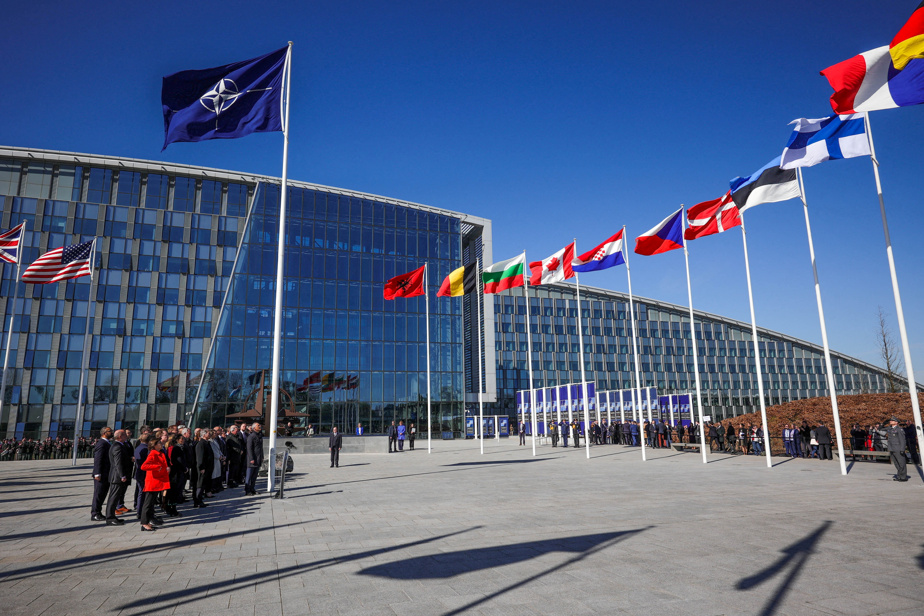During her visit to the United Kingdom last week, Defense Minister Anita Anand met with her British counterpart to discuss common issues, including the war in Ukraine.
Unlike Ben Wallace, Minister Anand refused to commit herself to Ukraine’s NATO membership. This position is not only contrary to Canada’s past commitments, it will also make Canadian defense policy more costly, less credible and less effective.
In view of the NATO summit in Vilnius on July 11 and 12, Prime Minister Trudeau should review the Canadian position and promote a formal process for Ukraine’s accession to NATO.

PHOTO STEFAN ROUSSEAU, ASSOCIATED PRESS ARCHIVES
Canadian Defense Minister Anita Anand (left) and her British counterpart Secretary Ben Wallace on June 29 in London
During the NATO summit in Bucharest in 2008, Prime Minister Harper advocated full membership of Ukraine and Georgia in the Atlantic Alliance. At the time, the majority of European countries opposed it, arguing that such a move would provoke Russian aggression. February 24, 2022 demonstrated that Russia did not need an excuse to invade Ukraine.
The lack of allies willing to defend Ukraine led President Putin to believe that a blitzkrieg would allow him to bring down the Ukrainian government and take control of the country.
If the allies had adopted the Canadian position in 2008, the Russian president would have thought twice before ordering a brutal attack on Ukraine. The Ukrainians would not have paid blood money and the allies would not have paid tens of billions to support Ukraine, including more than a billion from Canada.
A guarantee for the future
Ukraine’s NATO membership is the best way to prevent future Russian aggression – and the cheapest. By refusing, as in 2008, a formal membership process, the allies will signal to the Kremlin that it is possible to win the war by continuing its military occupation of Ukraine.
Peace in Ukraine rests on the ability to impose prohibitive costs on Russia, so as to force it to end its invasion. By denying Ukraine membership of NATO, the allies will have to significantly increase their military support for Ukraine if they wish to convince Russia that the invasion is not worth it.
Allies are debating other ways to signal their solidarity with Ukraine beyond formal NATO membership. Some propose, for example, the offer of security guarantees without a formal treaty of alliance. However, Ukraine already benefited from such guarantees, in the Budapest memorandum of 1994, which did not prevent the Russian invasion.
The main fear of formal membership is the belief that it would force the allies to defend Ukraine and, therefore, force them into direct war against Russia. Such a scenario is obviously to be avoided, but it is not inevitable.
Membership is not automatic
Launching an accession process does not mean that Ukraine would be a member immediately and that the allies would have to invoke article 5 which stipulates that aggression by one of the allies is aggression against all allies. The usual accession process is through a Membership Action Plan (AAP), which imposes conditions (eg democratic reforms) that take years to achieve before accession. Thus, Montenegro joined NATO 8 years after the start of the PAA, the Republic of Macedonia 11 years, and Bosnia and Herzegovina is still not a member after 13 years of the PAA.
Of course, Finland joined NATO in less than a year due to the lack of membership conditions. This is not the most likely and suitable model for Ukraine, as the latter will have to make a significant number of reforms before it can join the Alliance.
In other words, the offer of an AAP to Ukraine at the NATO summit in Vilnius would not result in immediate membership or an automatic defense obligation, but would signal to Putin that there is no point in prolonging his war. : Ukraine will never be under his fold.
Ukraine’s NATO membership would not be a panacea. The Baltic countries are members of the Alliance, but nevertheless require the presence of tens of thousands of Allied troops on their territory in order to dissuade Russia from invading them. But membership remains the cheapest option to ensure the security of Ukraine and Europe. It is much more expensive to prolong the war by not offering enough military aid to Ukraine to defeat the Russian forces on its territory or by increasing its aid in order to give it the means to repel the aggressors.
The best way to end this war is to make President Putin understand that no victory is possible. Doing so requires changing the perception that Russia will be able to control Ukraine if it continues its invasion long enough, until the West – and a new US president – tires of supporting Kyiv.
Ukraine’s NATO membership is the least expensive way to end the war. Let’s hope that the Trudeau government will have the courage to work for peace.

